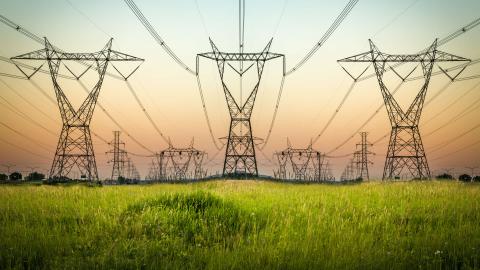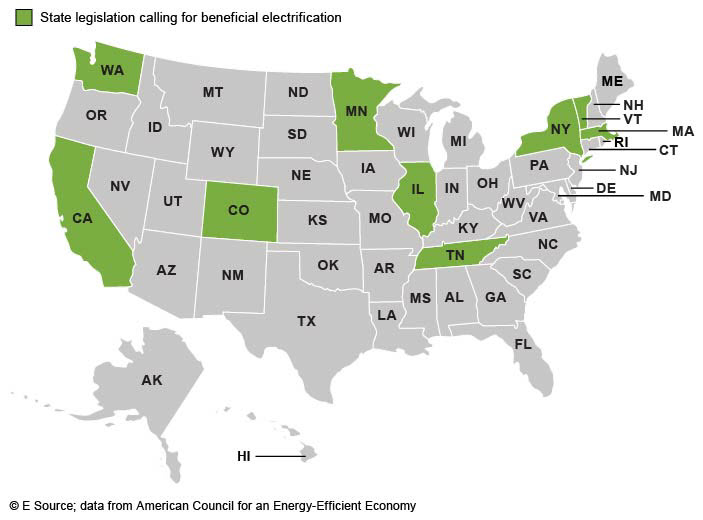
To understand the current state of building electrification (BE) and how it’s incentivized, we’ve been developing a database of utility and public BE programs in the US and Canada. It currently contains over 195 programs. By having a full picture of the nature of these programs, E Source can better guide utilities that are looking to start or advance their electrification offerings.
We’ve developed the BE program database over the past three months as part of our summer internship, focusing solely on incentive programs. In the future, the research could expand to other program types, such as training, public awareness, and technology demonstration.
We used a combination of E Source DSMdat and public sources to gather the information. And we often referred to the American Council for an Energy-Efficient Economy’s State Policies and Rules to Enable Beneficial Electrification in Buildings through Fuel Switching (PDF). We also closely tracked legislative changes on fuel-switching.
We’re excited to share more about our BE research with our members. Here, we’ll highlight some insights on what we’ve found.
Trends in fuel-switching and electrification programs
States and provinces that explicitly allow fuel-switching and promote electrification include British Columbia, California, Colorado, Illinois, Maine, Massachusetts, Minnesota, New York, Tennessee, and Vermont. Many states prohibit fuel-switching, and others have no policy on it. But this landscape is ever changing.
States that promote fuel-switching often have carbon-reduction goals with electrification as part of the solution (figure 1). States that prohibit fuel-switching can only allow electrification measures for new construction. This is the case for Washington State, which passed a law that requires all new commercial and large multifamily buildings to install all-electric heating at the time of construction but doesn’t allow incentives for fuel-switching.
States and provinces that do allow fuel-switching are the current leaders in electrification. British Colombia and California seem to have taken the greatest strides toward electrification.
Figure 1: States with beneficial electrification mandates
Examples of effective electrification incentive programs
There’s a variety of electrification incentive programs offered to both residential and nonresidential customers. The most common involves electric heat pumps for HVAC and water heating. Other common upgrade incentives focus on induction cooktops, electric panels, and electric appliances for commercial kitchens. Many programs offer several upgrades that customers can choose from.
Some of these programs offer gas upgrades, not just electric upgrades, allowing customers to make a choice while not promoting one or the other. We’ve also seen programs offer electric upgrades without specifying that fuel-switching is involved.
Here’s a sampling of programs that promote electrification effectively:
- SMUD Appliance Rebates includes an informational video about the benefits of induction cooking.
- Ameren Illinois Ground Source Heat Pump Incentive discusses the benefits of ground-source heat pumps over propane or gas heating.
- PSEG Long Island Geothermal Energy includes an informational video and flyer about the benefits of geothermal energy.
- Mass Save All-Electric Homes Incentive offers up to $40,000 in rebates for residential new construction.
- BC Hydro Combined Space and Hot Water Heat Pump Rebate provides the largest incentive for those switching from fossil fuels and includes the option for a panel upgrade rebate.
These programs explicitly promote electrification efforts and give useful information about each measure detailed in the offerings. They also include competitive rebates or financing.
The role of state- and province-wide programs in program implementation
Statewide programs have shown to be a great tool used to increase electrification offerings. These programs are typically affiliated with the government or a nonprofit organization. In each case, the government affiliate or nonprofit has a partnership agreement with utilities to offer programs that help the utilities reach goals around emissions reductions.
The third-party administrators’ main goals are to improve energy efficiency and fund the initiatives. So their time can be spent creating these programs to help utilities that might not have the bandwidth for such large efforts. The statewide programs explain energy efficiency effectively, providing customers with plenty of information and options. Some examples of statewide programs are detailed here.
New York State Energy Research & Development Authority (NYSERDA). NYSERDA’s heat-pump initiative, NYS Clean Heat, offers rebates and financing on heat pumps. NYSERDA and NYS Clean Heat are currently offering eight electrification incentive programs with options for all types of homeowners and business owners.
Efficiency Maine. An independent agency overseen by the Maine Public Utilities Commission, Efficiency Maine offers clean-energy rebates, loans, discounts, and consumer information. Efficiency Maine offers seven electrification incentive programs.
Mass Save. Mass Save is a partnership between six Massachusetts utilities, managed by sponsors who work closely with the Massachusetts Department of Energy Resourses to provide energy expertise. There are currently seven electrification incentive programs.
Clean BC. Clean BC is a governmental clean-energy roadmap. It currently offers 15 electrification incentive programs plus rebate top-ups for residents in certain municipalities.
Efficiency Vermont. A clean-energy nonprofit, Efficiency Vermont is a statewide energy efficiency utility operated by Vermont Energy Investment Corp. that currently has five electrification incentive programs.
Customer engagement strategies and participation
Engaging customers is crucial for the large-scale adoption of all-electric technology. Results from the E Source 2021 Residential Electrification Survey show that many customers are still not driven to go electric. For example, 10% of business customer respondents in the survey said they were considering but haven’t started researching electric space heating or cooling. And 4% said they were considering and had started researching; 11% had already participated in, purchased, or leased electric space heating or cooling.
On the residential side, 16% of respondents said they were likely to switch their furnaces from natural gas to electric. The patterns look similar for other measures like electric water heating and induction cooktops.
From our market research, we know that respondents who have electrification technologies are more likely to recommend them to others. So in theory, these statistics should steadily increase as electrification becomes more common. Our market research also found that respondents who are likely to purchase electrification technologies are motivated by safety and reliability, which highlights the impact that informative program communications can have on participation.
The following programs emphasize customer engagement.
Clean BC. In the Heat Pump Group Purchase Rebate program, customers are qualified for a bonus rebate if they buy in groups, with the rebate amount increasing as the group increases. If the group includes 2–4 homes, for example, each participant receives a $200 rebate. And if the group includes 15–19 homes, each participant receives a $425 rebate. In this case, even if a homeowner decides not to join the group, the topic has been planted in many customers' minds and they’ve gained some insight into heat-pump technology and the benefits of going electric. It's a strategic way for utilities to have their customers act as salespeople.
PG&E. The Cooktop Loaner Program allows both residential and nonresidential customers to loan an induction cooktop for two weeks to test out the technology before making the switch.
NYS Clean Heat. The Clean Heating and Cooling Communities Campaign, backed by NYSERDA and participating electric utilities, teaches customers about clean heating and cooling systems. If customers choose to take part, they receive no-cost guidance from experts on the benefits of heat pump technology and the best option for them personally.
